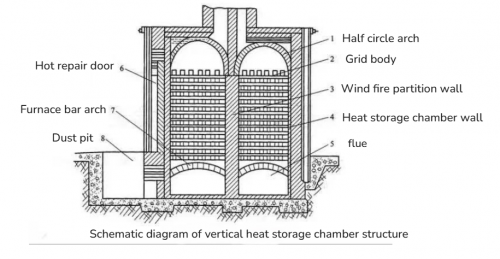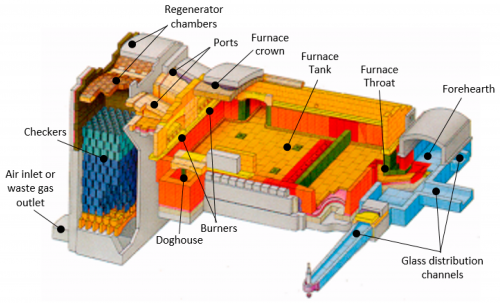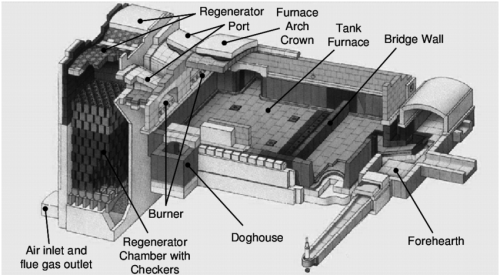The design of the checkerwork in the regenerative chamber of a glass furnace is a crucial aspect of the overall furnace design.
A well-designed checkerwork can significantly increase the preheating temperature of the combustion air, leading to higher combustion temperatures and providing both combustion and heating assistance to the entire furnace. It can also recover more waste heat from the flue gas and reduce the temperature of the exhaust gas. Moreover, it can decrease the volume of combustion exhaust gas, thereby reducing the emissions of harmful substances such as nitrogen oxides, sulfur and its oxides, and flue gas dust, which has a relatively obvious effect on environmental protection.
1. Basic Information of the Regenerative Chamber Checkerwork
The checkerwork in the regenerative chamber of a glass furnace is constructed with standard checker bricks, which are uniform in size, inexpensive, and have a short delivery time. The refractory materials used to produce the checker bricks should have a high density and a large thermal conductivity to ensure that the checkerwork has sufficient heat storage and heat exchange capabilities. Setting the preheating temperature of the combustion air and the temperature of the exhaust gas is an important prerequisite for the design of the checkerwork.
The function of the regenerative chamber is to exchange the waste heat from the flue gas in the melting zone of the glass furnace to the combustion air for heat recovery. The type of checker bricks, their arrangement, the size of the checkerwork’s pore diameter, the wall thickness (brick thickness), and the material of the checker bricks all affect the heat transfer performance of the checkerwork. The type of fuel has a significant impact on the radiation of the flue gas and is also a factor influencing the heat transfer performance of the checkerwork.
From a thermal engineering perspective, the pore diameter of the checkerwork has a direct impact on heat exchange, as a smaller pore diameter results in a larger unit heating area and heat exchange capacity of the checkerwork. However, from an operational perspective, a smaller pore diameter increases the resistance to gas flow and the possibility of clogging due to ultrafine powder in the batch or falling slag, which can affect the heat exchange capacity of the checkerwork.
2. Operating Conditions of the Regenerative Chamber Checkerwork in a Glass Furnace
The operating conditions of the regenerative chamber in a glass furnace are extremely harsh. It must withstand the erosion of high-temperature alkali vapor, flue gas, and various solid flying materials; it also has to endure the thermal shock caused by the alternating flow of combustion air and flue gas; and the lower bricks must bear the weight of the upper bricks. Generally, it can be divided into the following situations:
① Gas erosion by high-temperature alkali vapor and flue gas;
② Solid erosion by acidic and alkaline dust flying materials in the batch and harmful impurities in the fuel. ; ③ Liquid erosion caused by liquid sulfates in the condensation zone;
④ Fatigue damage to the bricks due to structural stress and thermal stress resulting from the alternating temperature changes caused by reversing;
⑤ Chemical reactions in oxidizing and reducing atmospheres that destroy the structure and crystal phase of the bricks;
⑥ The bricks at the lower layer bear the weight of the bricks above them, generating significant compressive stress.
3. Support layer for the checkerwork
The checkerwork of the regenerator cannot be directly built on the leveling bricks of the furnace arch, because the centerline spacing between adjacent furnace arches in the transverse direction of the melting furnace is twice the checkerwork module, while the width of the furnace arch is only 150mm, and the interval between them is generally larger than the external dimensions of the checker bricks. One furnace arch cannot directly support two rows of checker bricks at the same time. Therefore, a layer of support bricks for the checkerwork is used for transition. Structurally, this is equivalent to adding a layer of transition small beams on the two adjacent furnace arches, and the checker bricks can be laid according to the checkerwork module on the top of the support bricks.
The support bricks for the checkerwork are in an inverted convex shape with flanges at both ends. The upper length of the support brick is approximately twice the checkerwork module, and the length of the flanges at the bottom is approximately the interval between the two furnace arches. The support bricks should be evenly laid on the top of the leveling layer of the furnace arch according to the checkerwork module size. This way, the adjacent two furnace arches can be fixed at the flange length interval, and the top surface of the support bricks can form a laying platform suitable for the checkerwork module. The upper length of the inverted convex-shaped support brick should be slightly smaller than twice the checkerwork module size, considering thermal expansion, usually a gap of 5mm is needed. The support bricks near the inner and outer walls have different flange sizes at both ends and slightly different brick lengths, which need to be designed according to different situations. The height of the checkerwork in the regenerator includes the height of the support layer.
4. Hole diameter of the checkerwork in the regenerator of the glass melting furnace
To achieve the set preheating temperature of the combustion air, the regenerator of the glass melting furnace must have a corresponding checkerwork volume and heat exchange area. The hole diameter of the checkerwork plays an important role in the volume of the checkerwork, as well as its length, width, and height, and also has a significant impact on the heat exchange efficiency of the checkerwork.
If the content of ultrafine powder in the glass batch is high, the hole diameter of the checkerwork in the regenerator should be 150-170mm. The actual situation of most glass melting furnaces in China is that the hole diameter of the checkerwork is 160mm for cylindrical bricks and 165mm for strip bricks. This is the result of long-term production practice optimization.
5. “Reasonable value” of the horizontal cross-sectional area of the checkerwork in the regenerator
The volume of the checkerwork is determined by the product of the horizontal cross-sectional area and the height of the checkerwork. The horizontal cross-sectional area of the checkerwork is closely related to the number of small furnaces, the centerline spacing of the small furnaces, and the width of the regenerator. Different tonnage and energy consumption glass melting furnaces should have corresponding “reasonable values” for the horizontal cross-sectional area of the checkerwork.
Due to the diversity of checker brick parameters, the concept of “reasonable value” is more accurate. If any one (or several) of the number of small furnaces, the centerline spacing of the small furnaces, and the width of the regenerator are not properly designed, it may cause the horizontal cross-sectional area of the checkerwork to deviate from the “reasonable value” range, resulting in changes in the airflow distribution in each hole of the checkerwork and the airflow velocity, and further causing changes in the heat exchange coefficient of the entire checkerwork.
If the “reasonable value” is smaller, the height of the checkerwork needs to be increased, otherwise the heat exchange capacity of the checkerwork will be insufficient; if the “reasonable value” is larger, the gas flow in each hole of the checkerwork will decrease, the airflow velocity will also decrease, and the heat exchange coefficient of the checkerwork will also decrease. Although increasing the horizontal cross-sectional area of the checkerwork and thus increasing the volume of the checkerwork, the actual heat exchange capacity of the checkerwork does not increase proportionally, or even does not increase much. If it is much larger than the “reasonable value”, the unit energy consumption may need to increase significantly to ensure the normal operation of the glass melting furnace.
6. The height dimension of the checkerwork in the regenerative chamber
The height dimension of the checkerwork in the regenerative chamber of the glass melting furnace has gradually increased over time. In the early days, the height of the checkerwork in the regenerative chamber was very low, mainly due to the limitations of the refractory materials used at that time. Later, it was gradually increased. About 50 to 60 years ago, the height of the checkerwork in the air regenerative chamber reached 5 to 6 meters. About 30 to 40 years ago, it reached about 8 meters. In the future, it can still be further increased. With the continuous improvement of the performance of the refractory materials used in the checkerwork and the increasingly urgent requirements for energy conservation and emission reduction, the height of the checkerwork should be further increased.
Today, the height of the checkerwork in the regenerative chamber of most glass melting furnaces is about 8 meters, corresponding to a preheating temperature of the combustion air of about 1100°C and an exhaust gas temperature of about 600°C. If the height of the checkerwork is increased to 9 to 10 meters, the preheating temperature of the combustion air can be increased to about 1200°C and the exhaust gas temperature can be reduced to about 500°C, achieving energy conservation and emission reduction of about 5% each. Of course, as the height of the checkerwork increases, the investment in the factory building infrastructure will also increase.
7. Traditional methods for designing the checkerwork in the regenerative chamber of a glass melting furnace
The heat transfer situation inside the checkerwork is very complex and belongs to unstable heat transfer. It is very difficult to design the checkerwork using heat transfer calculations. In the early days, when designing the checkerwork, the area of the melting zone was taken as the base, and the heat exchange area of the checkerwork was determined according to 25 to 45 times the area of the melting zone. The range of difference was very large and very rough. Later, some empirical methods or empirical formulas for designing the checkerwork emerged. These methods were based on the volume of combustion air (fuel gas) required per second during the operation of the melting furnace for the design of the checkerwork, which improved the accuracy and were simple and practical.
The empirical method proposed by the former internationally renowned sintered refractory material supplier, German DIDIER Company (now acquired by RHI Company), takes the volume of combustion air per second as the calculation base and configures a certain volume of checkerwork according to the size of the checkerwork holes. This can be called the “variable volume of checkerwork per unit combustion air”. Based on this volume variable and the unit volume of combustion air, the volume of the checkerwork on one side of the regenerative chamber of the melting furnace can be calculated, and then the design of the checkerwork can be completed according to other given conditions.
The empirical formula proposed by the American TECO Company also takes the volume of combustion air per second as the calculation base and configures a certain heat exchange area of the checkerwork according to the preheating temperature that the combustion air needs to reach. This can be called the “variable heat exchange area of the checkerwork per unit combustion air”, and a high-order calculation formula for calculating the preheating temperature of the combustion air based on this heat exchange area variable is provided. When using the TECO empirical formula to design the checkerwork, the preheating temperature of the combustion air must be determined first, and then the “variable heat exchange area of the checkerwork per unit combustion air” that can achieve this preheating temperature of the combustion air is calculated based on the high-order calculation formula (sometimes trial and error adjustments are needed). Then, based on the calculated heat exchange area variable and the required unit volume of combustion air for the melting furnace, the heat exchange area required for the checkerwork on one side of the regenerative chamber can be calculated, and finally the design of the checkerwork can be completed according to other given conditions. The TECO empirical formula is directly linked to the heat exchange area of the checkerwork and is more in line with the actual heat exchange situation.
8. Simplified formula for designing the checkerwork in the regenerative chamber
Although the regenerative chamber of a glass melting furnace is unstable heat transfer, the total heat released by the flue gas and the total heat absorbed by the combustion air in each reversing cycle are basically stable and constant quantities. Therefore, this stable total heat transfer can be expressed by a calculation formula: Heat transfer = Heat transfer coefficient × Heat transfer area × Temperature difference. Based on the preheating temperature that the combustion air needs to reach, the total heat transfer required by the glass melting furnace can be calculated through the heat balance of the checker. If the total heat transfer coefficient of the checker (unit: kcal/(m²·cycle·℃)) can be obtained and the logarithmic mean temperature difference between the flue gas and the combustion air can be calculated, the total heat transfer area of the checker can be determined, and then the volume of the checker can be easily calculated, thus completing the design of the checker.
Post time: Jul-06-2025




